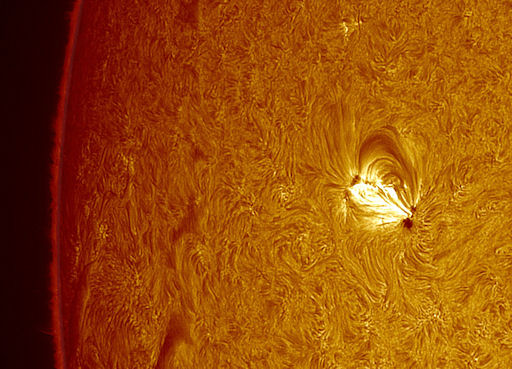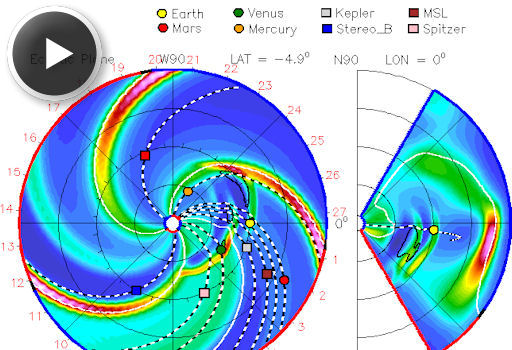SUNSPOT GENESIS: The solar disk is peppered with sunspots and at least three of them are crackling with C-class solar flares. Make that four. A new sunspot, AR1465, has just broken through the stellar surface to join the action. Cai-Uso Wohler photographed the emergence from his backyard observatory in Bispingen, Germany:
NOAA forecasters estimate a 30% chance of an M-class flare during the next 24 hours. As the youngest and least stable of the sunspots, AR1465 is the most likely source. Stay tuned for solar activity. Solar flare alerts: text, voice.
more images: from the Charlie Bates Solar Astronomy Project of Washington, DC; from Jim Werle of Henderson, Nevada; from Alan Friedman of Buffalo, NY; from Jett Aguilar of Quezon City, Philippines
INCOMING PLASMA CLOUDS: On April 18th and 19th, a series of minor CMEs puffed away from the sun. Three of them are heading in our general direction. Analysts at the Goddard Space Weather Lab have prepared an animated forecast track of the ensemble:
According to the forecast, the clouds are going to hit Mercury, Earth, Mars and rover Curiosity en route to Mars. The impact on our planet, on April 22nd around 00:50 UT, is expected to be minor with auroras likely only at higher latitudes. Aurora alerts: text, voice.

Solar wind
speed: 353.5 km/sec
density: 2.8 protons/cm3
explanation | more data
Updated: Today at 1635 UT
X-ray Solar Flares
6-hr max: C1 1528 UT Apr21
24-hr: C2 0132 UT Apr21
explanation | more data
Updated: Today at: 1600 UT
![]()
Daily Sun: 21 Apr 12
The solar disk is peppered with sunspots. Chance of M-flares today=30%. Credit: SDO/HMI
![]()
Sunspot number: 162
What is the sunspot number?
Updated 20 Apr 2012
Spotless Days
Current Stretch: 0 days
2012 total: 0 days (0%)
2011 total: 2 days (<1%)
2010 total: 51 days (14%)
2009 total: 260 days (71%)
Since 2004: 821 days
Typical Solar Min: 486 days
Updated 20 Apr 2012
The Radio Sun
10.7 cm flux: 142 sfu
explanation | more data
Updated 20 Apr 2012
![]()
Current Auroral Oval:
Switch to: Europe, USA, New Zealand, Antarctica
Credit: NOAA/POES
![]()
Planetary K-index
Now: Kp= 1 quiet
24-hr max: Kp= 2 quiet
explanation | more data
Interplanetary Mag. Field
Btotal: 8.2 nT
Bz: 2.5 nT north
explanation | more data
Updated: Today at 1635 UT
![]()
Coronal Holes: 21 Apr 12
There are no large coronal holes on the Earthside of the sun. Credit: SDO/AIA.





